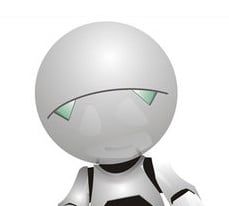I checked for others who, like me, are too European to understand the joke: 50°F is 10°C.
A nice swedish summer evening (if it isnt raining).
Edit: cheers my fellow scandinavians and nordics!
Or a nice winter in the Balkans.
You mean too rest of the world
Perfect for me would be more around 20°C
Ah, 10 is fine…
You mean to say that 50 °F is (approximately) 283 Kelvin, right? ;P
Shorts weather that one
I checked too before I saw your comment, I can confirm.
The hero we needed.
Thanks bro I was about to ask
Fahrenheit is like school grades: 60 is minimum tolerance and beyond 100 adds nothing but misery.
That’s not how school grades work were I live but I guess I now understand Fahrenheit
With school grades, when you get >100, you get bullied by your peers
Anything past 85F adds nothing but misery.
About 30C to the people who use real units
Is it bad that this association exists in my mind because of a Kids Next Door joke?
Hell yeah C’s get degrees while perfect A students tend to burn up in the world
50 is pretty nice what are you on about
Yeah, I’m not going to the beach at 50F, but I can hike, golf, just hang out outdoors, etc. If it’s sunny 50F can even feel rather warm.
Perfect running weather.
I don’t touch a jacket until 40, 50 is perfect.
That’s peak hoodie and jeans weather. Literally perfect.
I’d say 50 is perfect
This guy fats
I diagnose you with “weak, non-Finnish blood.”
Put a coat on, loser
Found the Canadian
Between 50 and 63 I’m in heaven. Anything higher than that and all i want to do is go swimming, which as an adult with responsibilities, i never get to. Anything lower than that, and i have to wear more clothes and look fatter than i am.
What the fuck, aren’t most buildings kept at 72? How do you exist anywhere except in a walk in fridge?
I never said i got these temperatures. I just said I’m uncomfortable otherwise.
Depends entirely on where you live. Surprising what people will accept as normal when their gas/electric bill is on the line.
64-68 °F is fairly standard here. No more than 68. (18-20 °C)
I agree in Midwestern as I put on my shorts and tshirt (I’m not fat, BTW… you just sort of get used to those balmy 50° days)
As a former Midwesterner (grew up there and lived there for 26 years), I never got used to the cold so I eventually moved South.
But turns out now I get cold at anything below 70F lol.
Not to defend Fahrenheit, it’s a nonsense scale, however: As with most subjective scales the entire scale can be split into good and not good. The top part is good and the bottom part is not good. The middle of the top part is seen as average good.
So around 75 degrees would be perfect, which is close enough for something as subjective as temperature.
This is why in things like movie or game reviews a 7/10 is seen as average. Like it’s good, in the good part, but right in the middle not anything special. A 5/10 or lower is seen as not good, not worth seeing, not worth your time etc. This works for reviews, grades, person attractiveness rating etc.
Yet, Temperature is not a nonlinear star-rating by IGN, is it?
Are you saying global warming is actually caused by the bias of IGN reviewers?
The flooding of Amsterdam was really epic, 10/10 IGN
Can you prove that?
Why not? Most people only meaningfully engage with temperature scales when checking weather forecasts. It’s all pretty subjective.
If course there’s a need for Celsius or Kelvin in scientific applications, but that’s not for the overwhelming majority of people.
but that’s not for the overwhelming majority of people.
Surely you’re aware that the overwhelming majority of people do not live in the US. Nearly everyone is fine with Celcius. Billions of people, as opposed to a few hundred million that have been socialised to using the other scale
75 perfect?
Well at least you have the right attitude the way our climate is headed
i appreciate your level headed analysis
There are many people (particularly in northern regions) who would consider 50° to be quite mild/pleasant
New Englander born and raised. Thats hoodie and shorts weather. Best time of the year.
Minnesota checking in. This is exactly correct. Great time for sitting around a fire.
Every time someone brings this up, another decade gets added until the US switches to Metric
You mean another eagle and five hamburgers.
Weather/room temp wise we probably never will. I’d rather think of my environment in terms of 0 to 100 than in terms of -18 to 38. For science and engineering, Celsius is ideal, and I can convert between the two in the very rare occasion I need to because I’m not an idiot who can’t do basic math.
That’s entirely a matter of habit. There is nothing special about 0°F (random point in the cold range?) or 100°F points (random point in the hot range?), you’ve been lied to.
We don’t think -18°C to 38°C, we think -50°C to +50°C (regular Celsius weather thermometer, covers almost any temperature observed on Earth), with 0°C differentiating between snow/ice, “wintery” weather, and rain/mud, “non-wintery” one. That’s how we know whether to take umbrella (no point if it snows, hat is your best friend), what kind of shoes are the best fit - cold-resistant or highly waterproof - or which kind of jacket is gonna fit the situation. Melting point of water is actually incredibly important weather-wise and entirely ignored by Fahrenheit scale.
When it’s not winter, normal range is 0-40°C, with 20°C designating comfort temperature.
For science and engineering, Celsius is ideal,
The SI base unit for temperature is Kelvin with 0 K being the coldest possible temperature. 273.15 K is the melting point of ice. But it’s a lot better suited for temperature differences. Celsius is only a derived unit.
And well, all units and measurement systems had a lot of changes over time because some things turned out to be impractical or inaccurate.
Initially Celsius had 100° as the freezing point of water, 0° as the boiling point of water. Fahrenheit had 0° as the coldest temperature he could produce and the (wrong) average human body temperature at 90°. Kelvin was initially defined via Celsius, that got reversed, they have the same scale. There is also Rankine, which starts at 0 like Kelvin, but uses the Fahrenheit scale.
And the US partially uses SI units anyways, all units are derived from them to use their superior base unit definitions. This system came into existence to have unit definitions that are better reproducible and change less over time. Since everything was redefined and all numbers changed anyways, they also tried to make use of the “new” decimal representation of numbers. And new unit names were nice to create some general units, in contrast to foot and pound, which were always different from place to place, at times even from city to city.
I don’t expect the US to ever switch. The US switched to international yard and pound instead of switching to a decimal system. After US, UK, Canada, Australia, New Zealand and South Africa agreed on that one, all countries who remained using these units had a uniform definition for them. Since then you don’t need to know any longer which yard or pound it was. Though not all units got standardized by that.
And some countries didn’t drop all old units and metricized some instead. Even SI kept the ton(ne). You can’t know what 1t exactly means without knowing the context, it can be 2240lb, 2000lb or 1000kg (~2204.6226lb).
Aviation is already backwards; aviators give distance to travel in nautical miles, visibility in statute miles, altitude and runway length in feet, speed in knots, weight in pounds, volume in gallons, and temperature in celsius. My favorite is the standard adiabatic lapse rate is given as 2°C/1000 feet.
Celcius us a horrible scale for science or engineering. The world literally explodes when water freezes.
Oh shit I better pull that ice out of my freezer then, I about blew up the world
If you score 100 on a test then that’s a perfect, therefore 100 is the perfect temperature.
And if you score 51 you pass, so 51 is the passing temperature.
💯
In Phoenix, can confirm, 100°F dry heat is pretty awesome
this meme also works in Celsius.
45 is very hot, 0 is very cold, 22.5 is ok
Ok is -273.15 C.
Nice.
22.5 is about the point where it starts being too warm
In a few years, with global warming on the rise, we may be saying that 50C isn’t that hot.
FML
Very hot in Celsius is like… in the 30s. At 100C you’d be dead.
We see 50C in Australia from time to time now thanks to global warming.
NGL I could be jogging outside at windless 50 degrees everyday. That would be a dream compared to my current life in the hell that is the 47th Latitude Great Plains Region.
50 degrees Fahrenheit
Unless you are literally a demon
Quite the opposite, I think anything above 28 C would kill me in a day or two.
I’m Mister White Christmas, I’m Mister Snow.
I’m Mister Icicle; I’m Mister Ten below.
Friends call me Snow Miser, whatever I touch,
turns to snow in my clutch.
I’m too much.
Dont kink shame
50 is indeed perfect.
Indoor temp? No. Outdoor temp? Yes!
No and no.
Fahrenheit is the best human-focused temperature scale. 0 is super cold, 100 is super hot, 50 is the line between short sleeve and long sleeve weather (assuming no wind). Anything outside these bounds, it simply isn’t worth going outside. But then everyone at a latitude <|37|° will say “that’s not that hot” and everyone at a latitude >|40|° will say “that’s not that cold,” so really it’s the best Kansas-focused temperature scale
Because weather is simple, right?
“It’s snowing so climate change can’t be real!”
Look, you’re entitled to your opinion but I think it’s a bit Kansocentric.
“the perfect scale”
Proceeds to list completely arbitrary temperatures and link them to completely subjective opinions
I can make all the same points about celsius with the added bonus of 0 and 100 being universally applicable and objectively measured
- 0 freezing
- 10 cool
- 20 room temperature
- 30 hot
- 40 very hot
Yeah I guess I agree, 0 to 40 makes much more sense in the context of temperatures humans typically exist in than 0 to 100
“It’s the best scale if you happen to live in the perfect conditions for it”
That last sentence was a largely facetious, poking fun at people who live in areas where it can get colder than 0° in winter or hotter than 100° in summer, who have a habit of telling other people that the extremes aren’t that extreme. In reality the fahrenheit scale is pretty useful the world around, barring deserts
I’m sure it’s useful, but it’s not really any better is what I mean
Most useful, or as some would say, best
69°F
Nice!
69 °C
A perfect temperature to slow cook beef ragu!
Inb4 nonlinear temperature scale
It’s the only way this meme makes sense. It’s a complaint that humans don’t like the average of the temperates that produce the feelings of extreme hot and extreme cold. You’d have to change math, change physiology, or lose linearity.
Nonlinear measures are used for
- Brightness of lights
- Loudness of noises
- Magnitude of earthquakes
Why not temperature?
None of those scales have negative scalars.
Actually, earthquake magnitude can be projected to negative numbers. It’s well defined but it stops describing earthquakes. For instance, a -3 magnitude earthquake is the energy released by a cat knocking your cell phone off of a nightstand. (see page 290 of this book). Pretty sure the others are also logarithmic scales which are well-defined for any negative number. It just so happens that those negative numbers don’t describe anything we care to describe with those scales.
That negative number comes from taking a logarithm of a number less than one. Not from a negative scalar.























